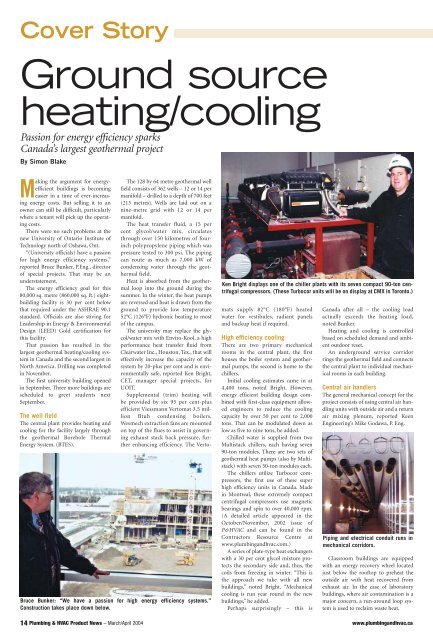CMX 2004 - Plumbing & HVAC
CMX 2004 - Plumbing & HVAC
CMX 2004 - Plumbing & HVAC
Create successful ePaper yourself
Turn your PDF publications into a flip-book with our unique Google optimized e-Paper software.
Cover Story<br />
Ground source<br />
heating/cooling<br />
Passion for energy efficiency sparks<br />
Canada’s largest geothermal project<br />
By Simon Blake<br />
Making the argument for energyefficient<br />
buildings is becoming<br />
easier in a time of ever-increasing<br />
energy costs. But selling it to an<br />
owner can still be difficult, particularly<br />
where a tenant will pick up the operating<br />
costs.<br />
There were no such problems at the<br />
new University of Ontario Institute of<br />
Technology north of Oshawa, Ont.<br />
“(University officials) have a passion<br />
for high energy efficiency systems,”<br />
reported Bruce Bunker, P.Eng., director<br />
of special projects. That may be an<br />
understatement.<br />
The energy efficiency goal for this<br />
80,000 sq. metre (860,000 sq. ft.) eightbuilding<br />
facility is 30 per cent below<br />
that required under the ASHRAE 90.1<br />
standard. Officials are also stiving for<br />
Leadership in Energy & Environmental<br />
Design (LEED) Gold certification for<br />
this facility.<br />
That passion has resulted in the<br />
largest geothermal heating/cooling system<br />
in Canada and the second largest in<br />
North America. Drilling was completed<br />
in November.<br />
The first university building opened<br />
in September. Three more buildings are<br />
scheduled to greet students next<br />
September.<br />
The well field<br />
The central plant provides heating and<br />
cooling for the facility largely through<br />
the geothermal Borehole Thermal<br />
Energy System. (BTES).<br />
Bruce Bunker: “We have a passion for high energy efficiency systems.”<br />
Construction takes place down below.<br />
Ken Bright displays one of the chiller plants with its seven compact 90-ton centrifugal<br />
compressors. (These Turbocor units will be on display at <strong>CMX</strong> in Toronto.)<br />
The 128 by 64 metre geothermal well<br />
field consists of 362 wells – 12 or 14 per<br />
manifold – drilled to a depth of 700 feet<br />
(213 metres). Wells are laid out on a<br />
nine-metre grid with 12 or 14 per<br />
manifold.<br />
The heat transfer fluid, a 15 per<br />
cent glycol/water mix, circulates<br />
through over 150 kilometres of fourinch<br />
polypropylene piping which was<br />
pressure tested to 300 psi. The piping<br />
can route as much as 7,000 kW of<br />
condensing water through the geothermal<br />
field.<br />
Heat is absorbed from the geothermal<br />
loop into the ground during the<br />
summer. In the winter, the heat pumps<br />
are reversed and heat is drawn from the<br />
ground to provide low temperature<br />
52°C (126°F) hydronic heating to most<br />
of the campus.<br />
The university may replace the glycol/water<br />
mix with Enviro-Kool, a high<br />
performance heat transfer fluid from<br />
Clearwater Inc., Houston, Tex., that will<br />
effectively increase the capacity of the<br />
system by 20-plus per cent and is environmentally<br />
safe, reported Ken Bright,<br />
CET, manager special projects, for<br />
UOIT.<br />
Supplemental (trim) heating will<br />
be provided by six 95 per cent-plus<br />
efficient Viessmann Vertomat 3.5 million<br />
Btuh condensing boilers.<br />
Wesmech extraction fans are mounted<br />
on top of the flues to assist in governing<br />
exhaust stack back pressure, further<br />
enhancing efficiency. The Vertomats<br />
supply 82°C (180°F) heated<br />
water for vestibules, radiant panels<br />
and backup heat if required.<br />
High efficiency cooling<br />
There are two primary mechanical<br />
rooms in the central plant, the first<br />
houses the boiler system and geothermal<br />
pumps, the second is home to the<br />
chillers.<br />
Initial cooling estimates came in at<br />
4,400 tons, noted Bright. However,<br />
energy efficient building design combined<br />
with first-class equipment allowed<br />
engineers to reduce the cooling<br />
capacity by over 50 per cent to 2,000<br />
tons. That can be modulated down as<br />
low as five to nine tons, he added.<br />
Chilled water is supplied from two<br />
Multistack chillers, each having seven<br />
90-ton modules. There are two sets of<br />
geothermal heat pumps (also by Multistack)<br />
with seven 50-ton modules each.<br />
The chillers utilize Turbocor compressors,<br />
the first use of these super<br />
high efficiency units in Canada. Made<br />
in Montreal, these extremely compact<br />
centrifugal compressors use magnetic<br />
bearings and spin to over 40,000 rpm.<br />
(A detailed article appeared in the<br />
October/November, 2002 issue of<br />
P&<strong>HVAC</strong> and can be found in the<br />
Contractors Resource Centre at<br />
www.plumbingandhvac.com.)<br />
A series of plate-type heat exchangers<br />
with a 30 per cent glycol mixture protects<br />
the secondary side and, thus, the<br />
coils from freezing in winter. “This is<br />
the approach we take with all new<br />
buildings,” noted Bright. “Mechanical<br />
cooling is run year round in the new<br />
buildings,” he added.<br />
Perhaps surprisingly – this is<br />
Canada after all – the cooling load<br />
actually exceeds the heating load,<br />
noted Bunker.<br />
Heating and cooling is controlled<br />
based on scheduled demand and ambient<br />
outdoor reset.<br />
An underground service corridor<br />
rings the geothermal field and connects<br />
the central plant to individual mechanical<br />
rooms in each building.<br />
Central air handlers<br />
The general mechanical concept for the<br />
project consists of using central air handling<br />
units with outside air and a return<br />
air mixing plenum, reported Keen<br />
Engineering’s Mike Godawa, P. Eng.<br />
Piping and electrical conduit runs in<br />
mechanical corridors.<br />
Classroom buildings are equipped<br />
with an energy recovery wheel located<br />
just below the rooftop to preheat the<br />
outside air with heat recovered from<br />
exhaust air. In the case of laboratory<br />
buildings, where air contamination is a<br />
major concern, a run-around loop system<br />
is used to reclaim waste heat.<br />
14 <strong>Plumbing</strong> & <strong>HVAC</strong> Product News – March/April <strong>2004</strong> www.plumbingandhvac.ca
















